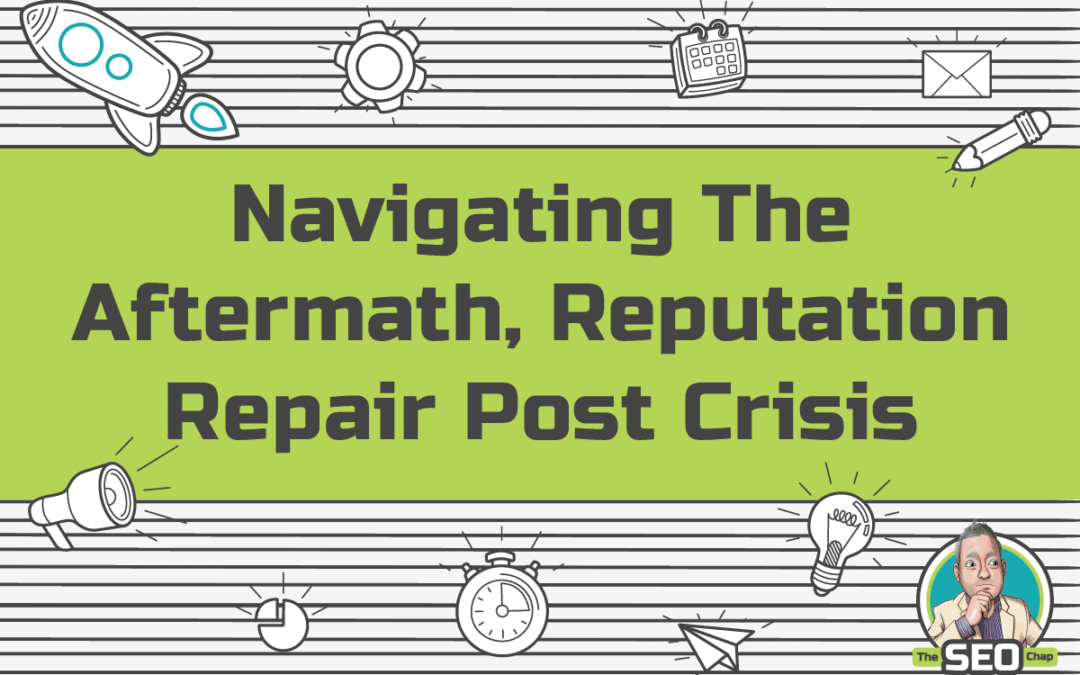In the aftermath of a crisis in your business, it’s normal for the team to feel overwhelmed. The damage done to your reputation online can seem insurmountable, and it may be difficult to know where to start with your online reputation repair post crisis.
But with the right plan in place, you can navigate the post-crisis landscape and restore your reputation. In this article, I’ll discuss how to:
- Assess the impact on your reputation
- Develop a repair plan
- Take responsibility for mistakes made during the crisis
- Establish trust with stakeholders going forward
To understand more about starting to rebuild your online reputation post crisis, let’s get started!
Understanding the Damage Done
It’s essential to comprehend the extent of the impairment caused in order to begin restoring one’s standing. In order to do this, it’s important to define expectations: what are realistic goals for reputation repair, and what can be done immediately?
It’s also essential to cultivate empathy; try to understand how others feel about the crisis and its aftermath. This includes understanding any pain or suffering that may have been caused as a result of the crisis. By fully understanding the damage done, it becomes possible to create an action plan that will help rebuild one’s reputation.
Reputation repair requires extensive effort on behalf of those involved, as well as a great deal of patience. Acknowledging any mistakes that were made during the crisis is key in regaining trust from those affected by it. Once trust has been rebuilt, then steps can be taken towards making amends and rebuilding relationships.
Taking responsibility for one’s actions can go a long way in repairing reputations – even if it means admitting fault publicly. Finally, staying honest throughout the process of rebuilding a reputation is extremely important. Communicating openly and honestly about progress being made goes hand-in-hand with taking responsibility for one’s actions in order to rebuild credibility over time.
Honesty and transparency should remain consistent when attempting to restore a damaged reputation – only then can true progress be made towards repairing relationships after a crisis has occurred.
Assessing the Impact on Your Reputation
The impact of a crisis on your reputation can be devastating, and also totally blown out of proportion, so it’s essential to assess the situation and take action.
Rebuilding credibility is important when it comes to repairing your reputation after a crisis. It’s essential to find ways to make sure that you’re still trusted in the eyes of those who matter most – customers, partners, and colleagues. You may need to take steps such as launching a public relations campaign or working with ethical influencers to help rebuild people’s trust in you and create consistency between the old and new versions of yourself.
It’s also important to identify what aspects of your reputation have been damaged and how much damage has been done. This will help you determine which areas need more focus when repairing your reputation post-crisis. Take some time to review online search results for any negative information that could have surfaced during or after the crisis and consider how this might have impacted people’s opinion about you or your business.
To repair your reputation, it’s essential that you evaluate all available options and use strategies that are tailored for your particular situation. This includes monitoring customer feedback, responding quickly to enquiries, offering compensation where appropriate, and ensuring transparency throughout the entire process. Taking these measures will show others that you care about rebuilding their trust in you while also giving them confidence in how seriously you take their opinion.
Developing a Plan for Reputation Repair Post Crisis
You’ve assessed the impact and identified what needs repair post crisis, now it’s time to develop a plan for rebuilding your reputation. A successful plan will need to focus on two key elements:
- Building empathy: You must show that you understand how those affected by the crisis feel and take responsibility for your actions. Make sure to listen with an open mind and let people share their stories without interruption or judgement.
- Strengthening relationships: Build or rebuild relationships with clients, customers, colleagues, stakeholders, or other parties affected by the crisis. Try to collaborate in order to find solutions and be willing to make amends where required.
Your plan should also include proactive steps such as creating content about the incident in order to demonstrate transparency and accountability. Be as honest as possible when discussing what happened and explain any measures being taken in order for a similar incident not to happen again. Additionally, it’s important that you measure progress through metrics such as surveys or interviews so you can assess whether your efforts are working or not.
By following these steps and putting together a comprehensive plan of action, you’ll slowly but surely begin repairing your reputation after a crisis situation has occurred – all it takes is dedication and consistency!
Taking Responsibility and Apologising
Taking responsibility for your actions and apologising to those affected is essential in order to start rebuilding trust. Acknowledging fault is the first step, as it shows that you’re aware of what happened. It’s important to be sincere when doing this, as well as offering solutions or a plan of action for how you plan to rectify the situation. Doing so will show that you’re taking your mistakes seriously and understand the gravity of the problem at hand.
Another part of taking responsibility involves understanding why the crisis occurred in the first place and taking steps to ensure it doesn’t happen again. This could involve reviewing policies or procedures, hiring additional staff, investing in resources, etc., depending on what caused the issue in the beginning.
Failing to do this could lead people to believe that you aren’t truly remorseful or committed to preventing future similar incidents from happening.
Finally, when it comes time for apologising for any damage caused by the incident itself, make sure that your words are clear and concise and accurately represent how sorry you really are about everything that’s happened. Your apology should come from an authentic place of understanding how badly things have gone wrong and being genuinely willing to make amends with those who were impacted by it all – regardless if they accept it or not.
Releasing a Statement to the Public Post Crisis
In the wake of a crisis, releasing a statement to the public is an essential part of rebuilding trust and restoring order. Acknowledging stakeholders and being transparent with communication are key components in this process. Without addressing these issues head-on, it can be difficult for organisations to move on from a traumatic event.
It’s important that statements issued include specific details about how the organisation plans to move forward in light of recent events, as well as demonstrate that steps have been taken to ensure similar issues don’t arise in the future. Enhancing communication with stakeholders can help maintain credibility and show that a positive outcome is possible despite any initial missteps or mistakes.
Being proactive and engaging with the public will also help build relationships between those involved and maintain transparency throughout this process.
The goal of releasing a statement should be to make sure everyone involved understands how the business thinks about its own reputation; taking ownership and responsibility for mistakes made while emphasising commitment towards making improvements going forward. This helps create an environment where open dialogue is possible, allowing all parties to work together towards finding solutions which benefit everyone equally.
Remedying the Root Cause of the Crisis
Once the statement has been released, it’s time to identify and remedy the root cause of the crisis. To do this, one must first pinpoint any triggers that caused the initial incident. This means looking for any underlying issues or problems that could have caused or contributed to the situation at hand.
From there, one can analyse how these potential triggers impacted and resulted in a crisis occurring. Lastly, solutions must be taken to address these issues and put preventative measures in place to avoid a similar situation from occurring again.
Next is understanding the effects of the crisis on stakeholders such as customers, employees, investors and other members of the public. How did they react? Was there a long-term impact? What can be done to remedy these effects? It’s important to understand how people were affected by something so that you can ensure appropriate actions are taken moving forward.
The last step in navigating through this process is implementing a strategy for recovery and ensuring everyone involved is following it properly. This includes creating specific action plans for each individual who was impacted by this event as well as making sure all processes are being monitored closely going forward so that further crises don’t occur down the line.
It also requires regular communication with stakeholders throughout every step of recovery and repair–from identifying triggers to analysing effects–to create an open dialogue about what happened and how it’s being addressed effectively.
Establishing Trust and Transparency
After identifying and remedying the root cause of the crisis, it’s time to establish trust and transparency with stakeholders. To do this, companies must start building credibility through their words and actions. This includes ensuring that all communication is honest, transparent and consistent. It also means being open to feedback from stakeholders, inviting conversations about how the company can improve its practices or even re-evaluate their goals or objectives.
Doing this will create a basis of trust between the company and those they serve. Fostering accountability is another important step in regaining trust after a crisis.
Companies should be willing to accept responsibility for any mistakes made during the crisis and take proactive steps towards correcting them. They should also communicate clearly with stakeholders on what measures have been taken to ensure similar issues won’t arise again in the future.
Finally, companies should show appreciation for those who continue to support them despite any negative press surrounding the situation by providing special offers or rewards where possible.
Through these two approaches – building credibility and fostering accountability – companies can not only rebuild their reputation post-crisis but also strengthen relationships with key stakeholders moving forward. After all, having strong relationships based on mutual respect is essential to weathering any storm that comes along in business today.
Developing a Crisis Management Plan
After establishing trust and transparency, it’s important to develop a crisis management plan that can help reduce risk and promote empathy.
This plan should consider the potential causes of crises, how they could be prevented, and what steps need to be taken in the event of an emergency. It should also address any policies or procedures that need to be put into place if a crisis were to occur.
It is important for organisations to cultivate empathy when creating their crisis management plans. This means considering the interests of those affected by a crisis – not just those of the organisation – when making decisions about how best to handle difficult situations.
Mitigating risk is equally important; this involves determining which risks are most likely and taking proactive steps ahead of time so that if something does happen, it won’t have as severe an impact on the organisation or its stakeholders. A well-thought-out crisis management plan can go a long way toward helping companies navigate difficult times with minimal damage done to their reputation.
Taking proactive measures such as developing procedures for responding quickly and efficiently, being transparent with stakeholders throughout any process, and cultivating empathy will ensure that organisations are prepared for whatever comes their way.
Conclusion
In the style of a simple mantra for you or your business…
- I’ve now outlined a plan for repairing the damage done to my reputation post-crisis. It won’t be easy, but I am confident that with hard work and determination, I can regain the trust of my stakeholders.
- I’m going to take responsibility for my mistakes and apologise sincerely. I will also make sure to remedy the root cause of the crisis and establish trust through transparent communication with my stakeholders.
- By creating a comprehensive crisis management plan, I’ll be better prepared in the event of another similar situation. With this plan in place, I can confidently move forward and restore my reputation in due time.


